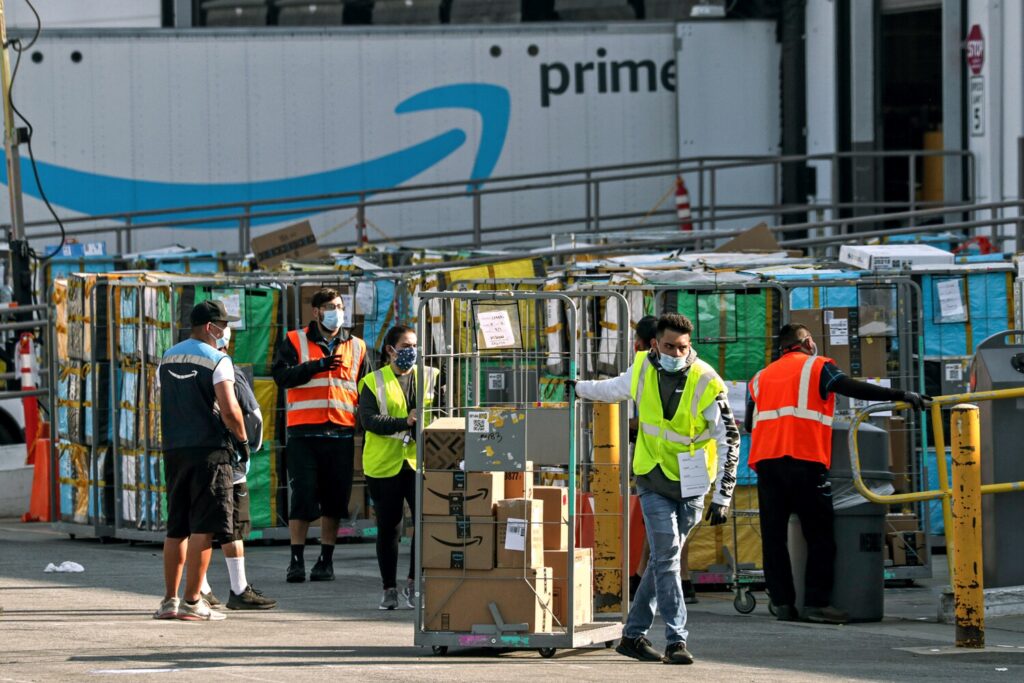Amazon plans to begin delivering some packages by drone to homes in a few Northern California communities this year, the company said Monday.
Residents of San Joaquin County farming towns Lockeford and Acampo, as well as parts of Lodi, will be able to order “thousands of everyday items” online and can expect a drone to drop them in their backyards in less than an hour, said Av Zammit, an Amazon spokesperson.
The Amazon Prime Air drones can carry packages that weigh 5 pounds or less — such as beauty and cosmetic items, office and tech supplies, batteries and household items — and will typically be the size of a large shoe box, Zammit said.
The company is building a facility in Lockeford from which the drones will launch.
Though Amazon Prime Air received certification to commercially fly cargo in 2020, it is still seeking approval from the Federal Aviation Administration and county officials for its plans in San Joaquin County.
Since Chief Executive Jeff Bezos appeared on a “60 Minutes” segment in 2013 to announce the e-commerce giant’s aspirations to deliver packages by air within four to five years, the company has cycled through various drone prototypes, each falling short of public rollout.
With mega-warehouses and their truck traffic adding to pollution in places such as the Inland Empire, drone deliveries have been mentioned as a way to reduce carbon emissions.
Last year, Business Insider reported that at least eight Amazon drones crashed during testing; last summer in Oregon, a drone fell 160 feet and crashed, sparking a brush fire, after its motor failed.
Amazon’s latest model is a hexagonal, propeller-driven aircraft with a “sense-and-avoid system,” which uses an algorithm to avoid hitting other aircraft, chimneys, people and other potential obstacles, the company said.
Customers will need to identify a suitable landing area with an Amazon employee. There, the customer will drop a marker, similar to a QR code. The drone will lower to about two to three yards off the ground, drop the package and fly away.
The FAA has required that human observers watch Amazon’s drones from takeoff until they are beyond eyesight. Amazon plans to request the removal of the safety precaution.
“Part of this is you learn as you go along,” Zammit said.
Raja Sengupta, a transportation engineering professor at UC Berkeley who has worked with drones for nearly 30 years, said the technology in autonomous drones is advanced enough for Amazon Prime Air to work. But given Amazon’s history of problems in testing, Sengupta expressed skepticism about factors such as poor weather and moving obstacles such as a dog or cat.
“It’s one thing to do it in a university or in testing, and it’s another thing to do it as a product that is sustainable and repeatable,” Sengupta said.
Amazon’s decision to lower the drone to make deliveries also drew concern from Sengupta. Competitors’ drones, such as those from Alphabet subsidiary Wing or Manna in Ireland, lower packages with a tether, while the drone hovers at a higher altitude.
“All of that is more difficult than what the rest of the industry is doing,” Sengupta said.
Amazon plans to expand drone deliveries to more densely populated, metropolitan areas such as Los Angeles.
With a population of about 3,500 people, horse and cattle ranches, orchards and vineyards, plenty of open land and low-density housing, Lockeford made the most sense as a first step, Zammit said.
Rindy Crawford, a manager at Ace Hardware in Lockeford, was surprised that Amazon had chosen the rural location to roll out its drone deliveries.
“We have one grocery store, two gas stations and a hardware store kind of thing — it’s not like we’re Stockton or Lodi or the Bay Area,” Crawford said.
She worried that the program would displace delivery workers.
“You miss out on that human connection, that one-on-one,” she said.
Amazon said it would solicit feedback from the community and would offer jobs at its new facility.

